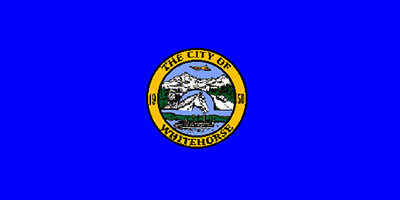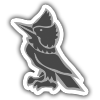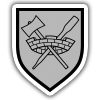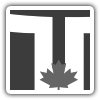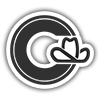Yukon, Canada
Flag
The flag of the Yukon was adopted by the territorial council in 1967. The green represents the forests, the white the snow and the blue the rivers and lakes. Centred is the territorial coat of arms with the floral emblem, the fireweed, below. The cross of St. George stands for the first explorers and fur traders from England, the roundel of vair symbolizes the fur trade, the white and blue wavy lines symbolize the Yukon River and the rivers and creeks where gold was discovered and the red triangles represent the mountains. The golden circles symbolize the territory's mineral resources and the malamute dog emphasizes the important role they played in the early history of the territory.
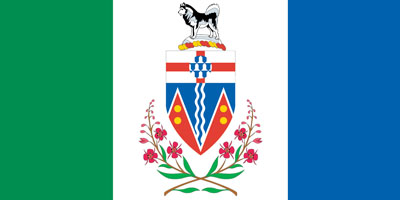
Other Provincial Symbols
- Floral Emblem: The Fireweed
- Tartan: Yukon Tartan
- Tree: Subalpine Fir
- Bird: Common Raven
- Gemstone: Lazulite
Coat of Arms
The Yukon coat of arms was granted by Queen Elizabeth II and adopted by the Yukon Legislative Council in 1956. The Cross of St. George at the top of the shield refers to the early explorers and fur traders from England, while the round panel of heraldic fur in the centre of the cross symbolizes the fur trade. The wavy white and blue vertical stripes in the lower part of the shield represent the Yukon River and gold-bearing creeks of the Klondike. The red spire-like forms represent the mountains of Yukon, and the two gold discs in each spire symbolize the territory's mineral resources. The crest above the shield features a malamute (or husky) dog standing on a mound of snow.
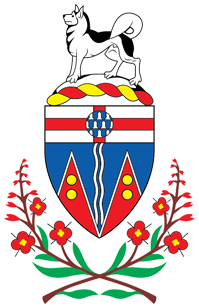

Origin of the Name
The territory's name probably comes from the word "Yu-kun-ah" meaning great river. In 1846, chief trader John Bell of the Hudson's Bay Company canoed down the Porcupine River to its confluence with the Yukon River, where he met natives who told him that the name of the big river was the "youcon." The Yukon River is the fifth longest in North America.

History
Yukon was probably the first area in Canada to be settled, following the migration of the ancestors of First Nations people across the Bering Strait land bridge from Asia to North America some 4,000 years ago. Language is central to Yukon First Nation heritage. The history and traditions of the many Yukon First Nations have been passed down through the generations orally by the teachings of elders. There are seven Athapaskan languages spoken in Yukon: Gwich'in, Han, Kaska, Tagish, Upper Tanana, Northern and Southern Tutchone. Tlingit is also spoken in southwestern Yukon.
In 1825, John Franklin became the first European to reach Yukon, then part of Rupert's Land, when he followed the Arctic coastline in search of the Northwest Passage. By 1848, the Hudson's Bay Company had established four trading posts on a traditional First Nation trading route.
In 1870, the Government of Canada acquired the territory from the Hudson's Bay Company and the entire region became known as the Northwest Territories. The boundaries of Yukon were first drawn in 1895, when it became a district of the Northwest Territories. Because of its remote location and severe climate, Yukon's population remained sparse until the discovery of gold.
After gold was discovered at Rabbit Creek (later renamed Bonanza Creek) in 1896, the Klondike became one of the most populated regions in the northwestern part of the continent as thousands of hopeful goldseekers headed north. By 1898–99, Dawson City, at the junction of the Klondike and Yukon rivers, was home to 40,000 people.
The sudden increase in population during the Klondike Gold Rush prompted the federal government to exert stronger control in Yukon. It became a separate territory in 1898 with passage of the Yukon Act. Dawson was chosen as the new territory's capital city. In 1953, the capital was moved to Whitehorse, the territory's most populous city and the centre of its economic activity.
Between 1896 and 1903, more than $95 million in gold were mined from the Klondike region. But once the easily extracted placer gold was depleted Dawson's population dropped to 8,512 by 1911. Today, its population is approximately 1,200. However, the Klondike is still a major tourist attraction in Yukon. August 17, "Discovery Day", is an annual holiday celebrating the anniversary of the initial discovery of gold at Bonanza Creek.
When Yukon became a separate territory, the Yukon Act of 1898 provided for a Commissioner and a legislative council of six, all appointed by the Government of Canada. In subsequent years, elected officials were included on the council; the first wholly-elected council was elected in 1909.
In 1979, an Executive Committee was established to assist the Territorial Commissioner in the executive function, and the elected members of the Executive Committee or Council have progressively assumed greater responsibilities. With the formal introduction of party politics in 1978, the elected leader of the majority party in the legislature became known as the Government Leader. When responsible government was established in 1979, the Commissioner no longer participated in the Executive Council. The Government Leader has the authority to determine the size and the appointments to the Executive Council, paralleling the function of the premiers in the provinces.
Civic Flags
Whitehorse, Yukon
